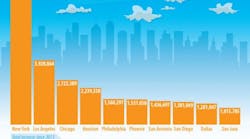The U.S. Census Bureau delivered an interesting report last week before the holiday break; a report that, by inference, indicates urban freight demand is only going to keep increasing as the number of American cities with populations exceeding the one million mark continues to grow.
New York City remains the nation's most populous urban locale at just over 8.49 million residents, up by 52,700 people as of July 1, 2014, the time period for which the agency has the most recent data.
[As a side note, one filmmaker predicated one of his campiest films on the premise that NYC would be a gigantic maximum security prison by 1997. Let’s hope THAT particularly grim vision never comes to pass!]
San Jose, CA, by the way is now among the 10 U.S. cities with a population of one million or more, according to estimates by the Census Bureau at just over 1.015 million residents.
Here are a few other interesting tidbits from the agency’s “most populous U.S. cities” report:
One reason such statistics are important is that such vast groupings of people means transportation and freight requirements increase significantly – a trend related to the global growth of “megacities” touched on in this space before.
Larger numbers of million-plus cities will also change what kinds of trucks will be needed to serve their freight needs.
Indeed, Frost & Sullivan’s Sandeep Kar noted in a report five years ago that medium-duty hybrids might be the ideal truck to serve such dense urban locales in the future.
[Or perhaps a fake Ferrari like the one driven by Ferris Bueller through the streets of Chicago.]
[And for those of you wondering … that car is a replica based off the 1961 Ferrari 250GT hand-built by Neil Glassmoyer of Modena Design and Development for the film. Plus, the song you hear in the background is “Beat City” by The Flowerpot Men.]
In sum, freight demand is not only poised to keep on growing in the U.S., it’s poised to perhaps grow most acutely in dense urban centers; trends that may change what kinds of trucks motor carriers will need to carry all of the goods folks living in such large cities will need on a daily basis.




